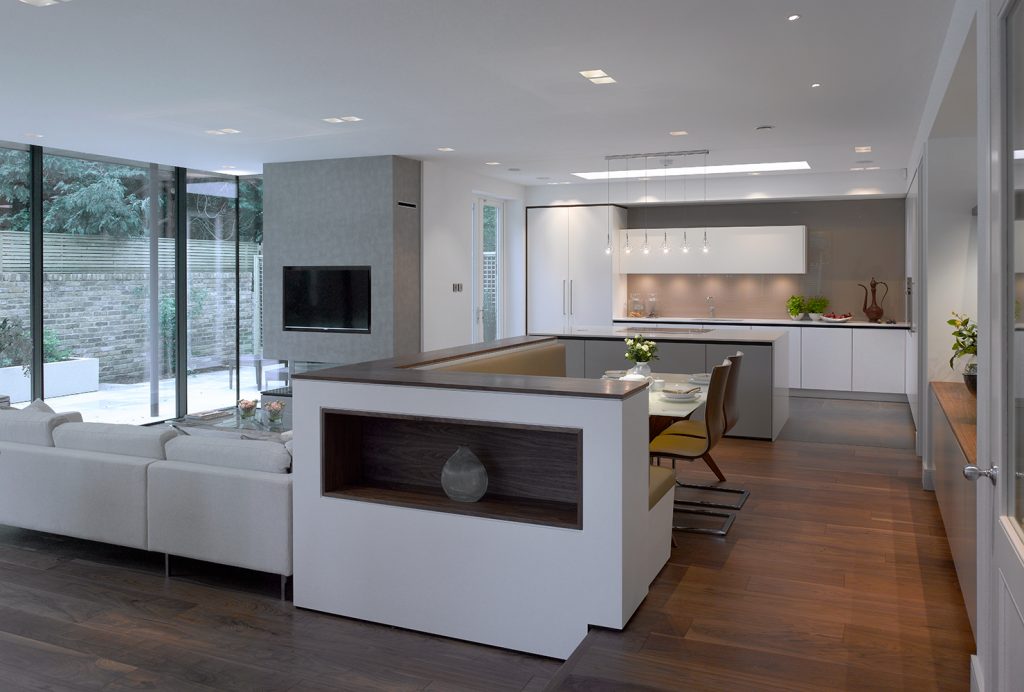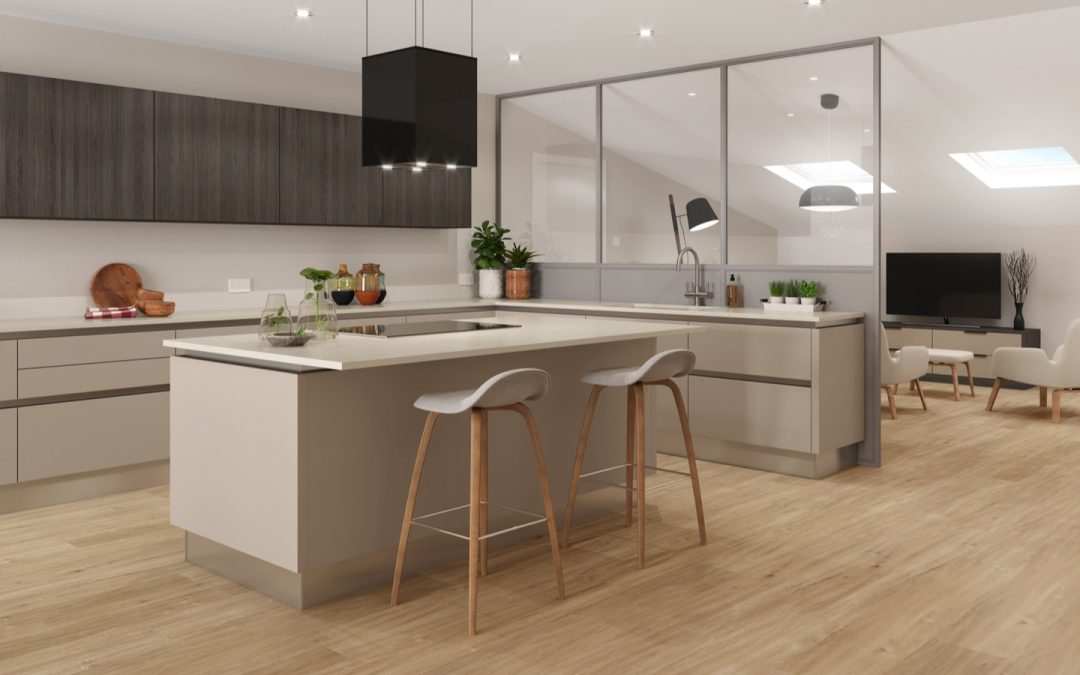First came open-plan kitchens, opening up an entire ground floor into a cohesive working and socialising space. Barriers like doors and walls were taken out to create a seamless area. The users of the space would share less privacy. The open-plan kitchen was revised, bringing about the broken-plan kitchen, which sees the semi-return of division through design by using structure and more defined areas. Broken-plan kitchens maintain all the positives of open plan kitchens, like light and openness but they also have zones creating additional privacy. Broken-plan kitchens aren’t part of a new trend, but are rather a natural extension of open-plan designs. It is recommended to visit a kitchen showroom in Scotland and get the assistance of a kitchen designer that will plan the layout of your broken-plan or open-plan kitchen. There are various home improvement ideas in both types of kitchens. The differences between open-plan kitchen and broken-plan kitchen will be explored. Kitchen renovation in an open-plan and broken-plan setup will be delved into too.
The design of your open-plan versus broken-plan kitchen
The kitchen island is seen in both open-plan and broken-plan kitchens. In your kitchen renovations in Scotland, the kitchen island acts as an architectural statement, a room divider, storage area, work station, a way of hiding plumbing and electrical work and it acts as a seating area. A broken-plan kitchen relies on more than a slab to create distinct areas. Physical barriers like open-plan shelves and half-walls are also seen. Zoning your kitchen through your kitchen renovations with shelves and half walls physically divide the area, adding levels. This distinguishes between cooking and eating sections, giving these areas a separate space while still being seamless. The kitchen designer from the kitchen company you are using will discuss with you the zoning home improvement ideas they have.
The benefits of open-plan and broken plan kitchens
The benefits of open-plan living are evident. Removing physical obstacles like walls makes a space feel bigger and allows better interaction between family members. As a result, open-plan and broken-plan kitchens are popular. Many families are doing open-plan or broken-plan kitchen renovations opening up their kitchen space. Practical elements of the kitchen design need to be considered like adequate ventilation. An extractor fan will get rid of cooking odours. Having good acoustics in your kitchen will ensure noisy appliances don’t disturb other family members watching television or chatting in the dining or living zone of the kitchen.
The colour palette in your open-plan and broken-plan kitchen
The broken-plan look can work in both traditional and modern style kitchens, or the furniture can combine elements of both styles. Combining colours and using wall levels creates separate zones in a broken-plan kitchen. In both open-plan and broken-plan kitchen renovations changing tone and texture in worktops and furniture defines areas in the kitchen. In broken-plan kitchens combining gloss or matt finishes on lacquered doors in wood, metals, stones and adding dashes of colour add contrast and break up cabinetry. In large kitchen renovations in Scotland, you can contrast the finishes of the island and wall run with, for example, a solid colour on one and neutral colours on another with one statement-making appliance to finish off the theme.
Add a focal colour to your broken-plan or open-plan kitchen
Adding a colour of contrast, against the neutral cream, white or grey such as a teal is important. Vibrant colours in kitchens are popular in kitchen renovations in Scotland nowadays. The clever use of colour as a home improvement idea in your kitchen creates definition and adds elegance. Teal is a nice contrast to neutral tones as it’s bold and adds a welcoming, homely element to your kitchen. Ask the kitchen company you are using’s kitchen designer about a focal colour in your kitchen.
Using colour to differentiate areas in open-plan living
A simple floor rug or matching scatter cushions can visually separate a living area from a
dining area. Or using different wallpaper designs in different areas creates a distinction between the areas and their usage in the kitchen. Different colour flooring also distinguishes between two areas.
Using structural elements to separate areas of the kitchen
As discussed rather than using colour and texture as seen in open-plan kitchens, broken-plan kitchens use structural elements like half walls, shelf dividers, levels, glass walls and mezzanines to differentiate between areas of use. These kitchen renovation ideas are widely used in broken-plan kitchens in Scotland.
Creating zones in your open-plan and broken plan kitchens
Also, visually separating the dining and living space can be done by using different flooring materials. This distinguishes between different areas without using walls. You can also create separate areas using different floor finishes, flooring levels and floating partitions like bookcases or screens. This allows the spacious feeling of open-plan living with separate areas for privacy. Mezzanines are a good way of creating extra room in households. They also create a visual distinction between different zones that have different purposes. Mezzanines work well for kitchen and living areas, with the cooking as well as eating space on the lower level with an area for relaxing above. The kitchen is a busy hub so having a separate relaxing area works well. Glass balustrades can link the spaces and let light reach the higher floor.
A less expensive kitchen home improvement idea is low partition walls forming separate areas that don’t impact on sociability. Alternative structural elements are columns or steps that separate the space without cutting the different areas off. A small change like widening a doorway between a kitchen and dining area will add a seamless element.
Choosing the appropriate kitchen materials
Kitchen materials add connections in your space. Try using a dining table and chairs in the same type of wood material as your solid wood breakfast bar on your customised kitchen island. The kitchen designer you are using from the kitchen company you visited will help you discuss options during the planning and design phase. They will have a host of ideas for you as well as bespoke kitchen home improvement ideas to make your open-plan or broken plan kitchen seamless. The furniture you choose should be well-chosen to fit the style of your kitchen. This is critical, particularly when your kitchen space extends into your living space. Match your dining room table and chairs in colour to the chairs at your kitchen island, for example. This shows a continuous wood theme that is elegant and homely.

The challenges faced in large broken-plan and open-plan kitchens
A larger kitchen gives a variety of areas to utilise, but can pose a challenge for kitchen designers. Creating a bigger open-plan kitchen space that doesn’t look like several different rooms and has a sense of continuity is the challenge. The kitchen designer you are using will need to consider functional and aesthetic needs in your large kitchen, and the same applies in a small galley kitchen. Creating a sense of flow between the various zones in the kitchen is critical. The “work triangle” is still used in open-plan and broken-plan kitchens. The kitchen’s three main work areas, the sink, fridge and stove should be laid out in a triangle. The leg of the triangle shouldn’t be less than 4 feet or longer than 9 feet for the optimal distance on foot between each area.
Large scale broken-plan and open-plan kitchen design
It is a trend that homeowners want to make their kitchen a larger space in their home through broken-plan and open plan kitchens. A kitchen renovation project can use physical and aesthetic barriers to differentiate between different areas in a cohesive space. In broken-plan kitchens colour, textures and cabinet styles make up functional and trendy broken plan kitchens. It’s not only achieved by using open shelving and half-walls.
Larger kitchens can sometimes lack warmth which is why clever choice of surface materials is significant. Floor, wall and worktop surfaces can be seen during the day and at night, so they have a big impact. Quartz or ceramic mimics the beauty of marble worktops adding character to your space. Mixing colours helps with space zoning too.
Tying together your open-plan or broken plan kitchen design
Open-plan kitchens came about before broken-plan kitchens which are an evolution of open-plan layouts. Broken-plan kitchens use structure and more defined areas. Broken-plan kitchens utilise all the positives of open plan kitchens, like light and openness but they also have zones creating additional privacy. Open-plan living is popular. Removing physical obstacles like walls makes a space feel bigger and encourages better interaction between family members. Using a focal colour and neutral colour in open-plan and broken-plan living works well. In open-plan layouts a simple floor rug or matching scatter cushions can visually separate areas. Making use of different wallpaper designs in different areas creates a distinction between the areas and their usage in the kitchen. In broken-plan kitchens structural elements create zones instead of colour: like half walls, shelf dividers, levels, glass walls and mezzanines to differentiate between areas of use.
Choosing the appropriate kitchen materials and matching furniture at your breakfast bar and dining table creates a continuous theme. Floor, wall and worktop surfaces have a big impact. Quartz or ceramic mimics the beauty of marble worktops adding character to your space. Mixing colours helps with space zoning too. Open-plan living which has continued into a more evolved broken-plan living in kitchens will continue to trend. Incorporating the above design tips and home improvement ideas and making use of a kitchen company’s services will make your kitchen renovation process smooth so you can get the ideal open-plan or broken-plan layout in your dream kitchen.


Recent Comments